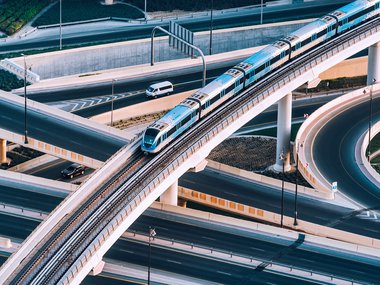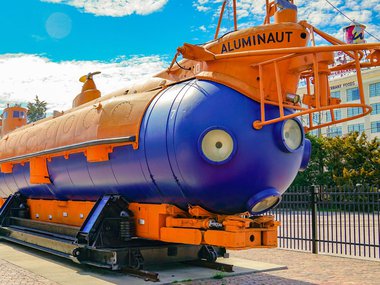Plane, Trains, a Submarine and a Capsule
Let’s Get Moving!
Whether diving deep into the ocean or orbiting Earth in space, the Science Museum has no shortage of modes of transportation that have taken people to a wide variety of places. Some have even set inspiring records!
Given the building’s history as a train station, it makes sense you’d see trains on display when you visit. But the Science Museum features more than trains: there’s an aircraft, a submarine and a spacecraft. In fact, these artifacts are some of the largest in the Science Museum’s varied collection.
Broad Street Station was contracted by the Richmond, Fredericksburg and Potomac Railroad (RF&P) and designed by New York architect John Russell Pope. Construction on the innovative new passenger rail station started in January 1917. On January 6, 1919, the first train left the station, thus the transportation history of our building began. During its decades of operations, hundreds and thousands of passengers—including well-known figures such as Elvis Presley and Winston Churchill—traveled through this historic building.
While train service ended in 1975, trains are still sitting on the tracks that remain from Broad Street Station’s heyday. There is a steam engine, three train cars and a caboose in the TrainYard, the outside portion of the Science Museum’s campus accessible from Level 0. Having some trains onsite helps guests not only understand the track system engineering so they can picture what the bustling station may have looked like in the 20th century, but also showcases some of the technological advancements the railroad industry made over the years.
The steam engine is a Chesapeake & Ohio Railway (C&O) Kanawha class K-4. These engines were named after the Kanawha River, which ran parallel to its main line. The 460,000-pound engine, as well as its 39 sister engines, were designed to move heavy freight and passengers across the C&O system. The Science Museum’s engine is unique because it still has its original tender, or coal car, which could hold 30 tons of the black sedimentary rock.
The Chessie System Caboose 904090 was constructed by Baltimore and Ohio Railroad (B&O). Rail companies began to add caboose cars to the back of trains in the mid-1800s. They served as rolling offices and quarters for the crew. The Science Museum’s bright yellow B&O Caboose is an example of a 1970s bay window caboose, which gave the crew a better view of both sides of the train than a standard railcar.
The American Railway Express Agency (REA) 138 is a refrigeration-turned-mail car. In the 1940s, the REA focused its business on moving meats, fruit and vegetables cross-country. Once one of the largest companies of its kind globally, in the 1960s business dried up due to the increased popularity of refrigerated trucks. REA pivoted by stripping out the refrigeration equipment and leasing the cars as bulk mail carriers. This is the only train in the Science Museum’s collection that guests may enter as guests may rent this space for hosting a birthday party.
The most glamorous of the trains on display at the Science Museum is Car ONE (pronounced car Oh-N-Ee). It was built by the American Car and Foundry Company in 1919. Before air travel became the norm, this car served as the rail version of a corporate jet by transporting executives and VIPs. Car ONE features luxurious accommodations, including a lounge with two beds, three bedrooms, a dining room, a bathroom with shower, an observation platform, an air conditioning system and a galley with a steward’s quarters. RF&P utilized the car to take clients to Washington, D.C., to watch home football games.
Designated to support Car ONE, the Science Museum also has the RF&P Kitchen Car 20. This rolling stock (another word used to describe vehicles used on a railroad) served as the onboard kitchen and housed the generator that provided electricity for lighting—and later air conditioning—for the rest of the train. The interior now features 1950s-style decor.
At the far end of the TrainYard, you’ll find the Aluminaut. This orange and blue underwater vessel was the first submersible to ever be built out of aluminum. It was also the first deep-sea submarine to travel 15,000 feet below the ocean's surface. Conceived and constructed by Richmond-based Reynolds Metal Company in the 1960s, the Aluminaut embarked on numerous underwater adventures. Some of its most notable dives include rescuing a Navy deep-sea submarine, assisting in the retrieval of a hydrogen bomb and taking oceanographer Jacques Cousteau on a research mission. To learn more about the Aluminaut, check out this video on our YouTube channel.
Moving inside the building, the Science Museum has two more vehicles in Speed. The massive SR-71 Blackbird hangs in the exhibition, making it the only SR-71 displayed in that suspended format. While every aircraft is an incredible scientific achievement, the SR-71 Blackbird stands out among the crowd. It accomplished feats that no other aircraft before or after it could, and to this day, holds many aviation records that will not easily be broken.
The CIA made a request to aeronautical and systems engineer Kelly Johnson and his Lockheed Martin Skunk Works® team for a high-altitude, Mach 3 reconnaissance aircraft. Thus, the SR-71 was born. The first Blackbird arrived at Beale Air Force Base in California in 1966, where it remained for the next two dozen years. Made of 93% titanium, only 32 SR-71s were ever built. Able to travel 2,193 miles per hour, the SR-71’s surface temperature could exceed 600℉. The Science Museum’s supersonic jet, SR-71 968, last flew in February of 1990. Watch a time-lapse of the SR-71 being installed in the Speed exhibition in 2015-16.
Last but certainly not least is Mercury-Atlas 6. As the third of six manned capsules that went into space as part of NASA’s Mercury program, this replica showcases Friendship 7, a name given to the capsule by its occupant. John Glenn was the first American to orbit the Earth, which he did three times in Friendship 7 for a flight that lasted 4 hours, 55 minutes and 23 seconds. Glenn’s Friendship 7 trip allowed the United States to see what space travel was really like, which ultimately led to major technological advances that have created new opportunities for cosmic adventures. Science Museum guests can climb into the model to get a feel for how small the spacecraft was, an experience that will certainly make them grateful for the spacious transportation methods we use for modern-day trips here on Earth!
From steam engines and glamorous train cars to deep-sea submarines and history-making space capsules, the Science Museum offers a look at not just modes of transit, but also more than a century of transportation evolution. If you haven’t already checked them out, get moving to the Science Museum to explore this collection of vehicles for yourself!


